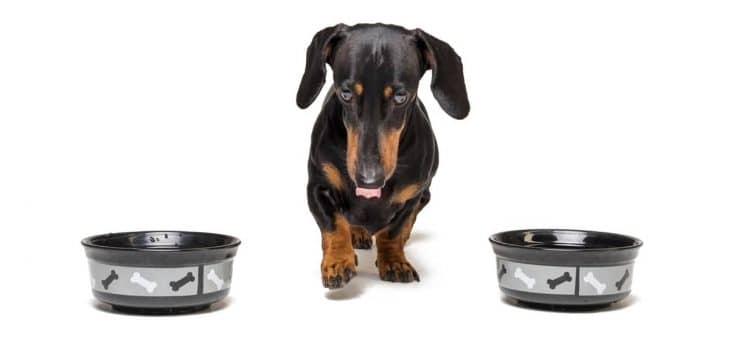While dogs aren’t as picky as cats, it’s not uncommon for them to sometimes refuse to eat a certain food. And, yet – sometimes it just has to be done. So, here we’ll talk about changing dog food within the same brand – the why, when, and how of it all. Additionally, we’ll go over the differences between that and moving to another brand, some of the problems that may arise, and other additional tips and tricks you can employ.
When Should You Change Your Dog’s Diet?
There are many different reasons to change your dog’s diet. Some are serious and urgent, others are less major but still valid. Here are the main reasons you may want to consider:
- Your pup is simply growing either into an adult or into a senior dog and it’s time to move on to a new type of food
- You’ve discovered a certain health issue such as diabetes, kidney disease, or a certain gastrointestinal issue that necessitates a diet change
- You’ve discovered that your previous dog food wasn’t of a high enough quality
- You want to diversify your dog’s diet
- You’re looking to reduce your dog’s weight
- You’d like to save money with a lower cost (but still good!) dog food
Either of those is a good reason to switch to a different food. Fortunately, your dog will take on the change well enough. If it doesn’t, read on to see a few solutions.
Why Consider Changing Dog Food Within The Same Brand?
Generally speaking, it wouldn’t matter much whether you switch to a different brand or just to a different flavor/type within the same brand. Either way, the ingredients will likely be quite different.
The first and foremost rule, in either case, should be the actual quality of the food. If you believe your current brand offers high enough quality across all its different types of food – stick with it. However, if the very reason for the switch is the low quality of the food then obviously, changing dog food within the same brand is a bad idea.
How Long Does Changing Dog Food Take and How To Go About It?
That will depend on the dog’s preferences and tendencies for stubbornness. Many dogs will happily switch to a new food whenever given the chance. However, in some cases, a dog can be obstinate for a few days or even a couple of weeks.
The most sure-fire way to deal with such a stubborn dog is to change its food gradually. This usually means mixing 75% of the old food with 25% at first. If the dog refuses that ratio, try 80/20 or even 90/10 if you have to. Whatever ratio is finally deemed “Acceptable” by your dog, stay on it for a few days.
Then, slowly start reducing the amount of old food and adding more of the new food. After about a week or so you can transition into a 50/50. After another few days to a week – 25/75. From there, the jump to 100% new food should be a matter of no more than a couple more days.
In total, even the most stubborn dogs should be ok with a full transition after 14 days if you’ve made the transition smooth enough.

Learn more about: Can Dogs Eat Maraschino Cherries Or Are The Drawbacks Too High?
Are There Possible Problems When Transitioning Dog Food?
While diet transitioning is often done to avoid certain health issues, it can also cause them, albeit rarely. Most notably, a sudden diet switch can lead to vomiting, diarrhea, gas, and overall an upset stomach. This doesn’t mean that there’s something wrong with your pet or with the dog food, however. Most of the time, the issue was just in the sudden switch.
So, if you’ve had to go through a slow and transitional switch, you most likely won’t face these issues. In fact, this is another way to avoid the stomach upset from a sudden switch – do it gradually as outlined above.
Naturally, you should still consult with your vet if you’ve noticed even a slight problem. Even though it’s probably nothing major, it‘s good to be careful.
My Dog Doesn’t Want To Eat At All – What To Do and Should I Wait?
On rare occasions, a dog may refuse to touch its new food even if it’s mixed in a 10/90 ratio with the dog’s old food. Canines do have strong noses, after all. In such a situation, waiting a bit can work as your dog may surrender after a couple of meals without eating.
This leads to another question – how long should you wait if your dog is extra stubborn? How long can dogs go without eating? Hypothetically, a dog can go without food for 3 to 5 days without any major health problems. However, that’s generally too risky. Going over 48 hours without food can – rarely – lead to some health issues. So, waiting 48 hours or 4 meals is generally acceptable.
Do keep in mind, however, that your dog may start looking for food elsewhere. Usually, this means going through the trash can or trying to open the fridge.
How To Switch Dog Food If Your Dog Is “Free Feeding”?
If you’re free-feeding your dog you can still try both a sudden and a gradual food switch. That being said, it’s a good idea to use the occasion to switch to a strict feeding schedule of 2 or 3 separate meals a day. The wait between meals will further incentivize your dog to eat when it’s given food.
Additional Tips and Tricks For When You Are Changing Your Dog’s Diet
Here are a few more tips that may help you:
- Remove the bowl after 20 to 30 minutes if your dog has refused to eat
- Mix some of your dog’s favorite food with the food
- Add another delicacy such as fish sauce or something else your dog likes
- If nothing helps, talk with your vet
So, Changing Dog Food – It’s Sometimes Difficult But Never Impossible
Even if your dog is extra stubborn about it, don’t despair. Just take things slow, make the switch gradual, and make sure your dog is eating at least once every 48 hours (or 24 hours to be extra safe). Sooner or later, with enough patience and persistence, your dog will get used to and accept the new food.
Read more about: Best Dog Food For Miniature Dachshund Dogs To Keep Them Healthy




